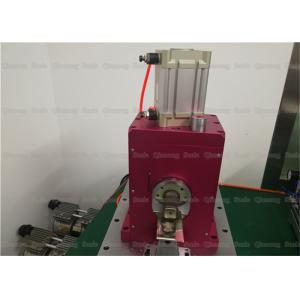

Add to Cart
Special Customized Reticulation for Ultrasonic Metal Welding Horn
with Imported Steel Mold
Description:
Ultrasound is widely used in medicine, military, industrial and
other industries due to its good directionality and strong
penetrating power. Ultrasonic metal spot welding machine is the
heat generated by the vibration friction of tens of thousands of
times per second of ultrasonic wave. The energy of ultrasonic
vibration is converted into friction energy and transmitted to the
metal surface, and then the external pressure is used to fuse the
molecular layer of the workpiece contact surface.
Specifications:
| Item No | QR-D2020A | QR-D2030A | QR-D2050A |
| Power | 2000W | 3000W | 5000W |
| Air Pressure | 0.05-0.9MPa | 0.05-0.9MPa | 0.05-0.9MPa |
| Frequency | 20KHZ | 20KHZ | 20KHZ |
| Voltage | 220V | 220V | 380V |
| Weight of horn | 55KG | 60KG | 88KG |
| Dimension of Horn | 550*280*380mm | 550*280*430mm | 550*380*660mm |
| Generator Size | 540*380*150mm | 540*380*150mm | 540*380*150mm |
Applicable Products:
1) Nickel-metal hydride battery Nickel-metal hydride battery nickel mesh and nickel sheet inter-melting and nickel sheet inter-melting.
2) Lithium battery, polymer battery copper foil and nickel sheet are mutually melted, and aluminum foil and aluminum sheet are mutually melted.
3), the wires are mutually melted, and they are entangled into one and a plurality of mutually melted.
4), the wire and various electronic components, contacts, connectors inter-melting.
5), the mutual melting of large-scale heat sinks, heat exchange fins and honeycomb hearts of various household appliances and automotive products.
6), electromagnetic switch, no fuse switch and other large current contacts, mutual melting of dissimilar metal pieces.
7) The sealing and cutting of the metal pipe can be water and airtight.
How does an ultrasonic welder work?
The principle of ultrasonic welding is to convert 50/60 Hz power
frequency to 20 kHz or more by ultrasonic generator. The converted
high frequency electrical energy is again converted by the
transducer into mechanical vibration of the same frequency, and
then the mechanical motion is transmitted to the welding head
through a set of amplitude varying amplitude modulators. The
welding head transfers the vibration energy to the joint of the
workpiece to be welded, in which the vibration energy is converted
into mechanical energy and thermal energy by friction, so that the
workpiece to be processed is welded. Ultrasonic waves can be used
not only to weld hard thermoplastics, but also to weld metals.
Ultrasonic welding of plastics generally uses the way the welding
head vibrates perpendicular to the workpiece. For some thin plastic
parts, the direction of vibration of the welding head can be
parallel to the workpiece. When ultrasonic welding of metal, the
direction of vibration of the welding head is parallel to the
workpiece.
Since vibration propagates in metal with various vibration modes:
longitudinal vibration, radial vibration, bending vibration, and
torsional vibration, it is possible to comprehensively analyze
which vibration mode is used according to the material to be
welded, and pressurize based on the vibration mode. The design of
the mechanism and the frame.
The main components of a set of ultrasonic welding systems include
ultrasonic generators, transducers/amplifiers/welding heads, molds
and frames. The main functions of the frame are fixed and stroke
pressurization mechanisms.
Special Customized Reticulation for Ultrasonic Metal Welding Horn
with Imported Steel Mold
